






Saving the endangered sea turtle
Who says you can't make a difference? Two Mexican biologists and
two American ecologists/entrepreneurs have taken a stand for sea turtle
populations that is having a profound effect. And, they're inviting you
to join them.
by Alice Martinez
 hroughout the world, there are a number of serious,
ongoing projects to restore and preserve sea turtles and their habitats.
What follows is the story of one such effort, located in nearby Baja California,
Mexico.
hroughout the world, there are a number of serious,
ongoing projects to restore and preserve sea turtles and their habitats.
What follows is the story of one such effort, located in nearby Baja California,
Mexico.
 In 1978, at the age of 24, Antonio Resendiz moved to
Bahia de Los Angeles to manage a sea turtle conservation project funded
by the Mexican Instituto de Pesca (Fish Institute). Bahia de Los Angeles
is a remote fishing pueblo located on the Sea of Cortez about 400 miles
south of San Diego. This region of bays and islands is host to one of the
world's richest aquatic communities. Visitors are often surprised while
snorkeling by curious sea lions, by orca feeding close by or by having their
boats escorted by playful dolphins.
In 1978, at the age of 24, Antonio Resendiz moved to
Bahia de Los Angeles to manage a sea turtle conservation project funded
by the Mexican Instituto de Pesca (Fish Institute). Bahia de Los Angeles
is a remote fishing pueblo located on the Sea of Cortez about 400 miles
south of San Diego. This region of bays and islands is host to one of the
world's richest aquatic communities. Visitors are often surprised while
snorkeling by curious sea lions, by orca feeding close by or by having their
boats escorted by playful dolphins.
 At Bahia de Los Angeles, Antonio lived and worked alone
in a pueblo of traditional fishermen and turtlers. He fought to educate
the local people about marine biology and the need to conserve the area's
aquatic life. His confiscation of illegally captured turtles and turtle
nets and his documentation of other illegal fishing practices sometimes
brought him into dangerous confrontations.
At Bahia de Los Angeles, Antonio lived and worked alone
in a pueblo of traditional fishermen and turtlers. He fought to educate
the local people about marine biology and the need to conserve the area's
aquatic life. His confiscation of illegally captured turtles and turtle
nets and his documentation of other illegal fishing practices sometimes
brought him into dangerous confrontations.
 In 1988, Antonio took on a research partner (and subsequent
marriage partner) Beatrice (Bety) Jimenez. Bety received her biology degrees
from the University of Michoacan. Prior to meeting Antonio, she had spent
ten years at a leatherback sea turtle nursery in Michoacan. Her work there
consisted in part of long nights walking the beaches to safeguard nesting
turtles and their eggs from poachers.
In 1988, Antonio took on a research partner (and subsequent
marriage partner) Beatrice (Bety) Jimenez. Bety received her biology degrees
from the University of Michoacan. Prior to meeting Antonio, she had spent
ten years at a leatherback sea turtle nursery in Michoacan. Her work there
consisted in part of long nights walking the beaches to safeguard nesting
turtles and their eggs from poachers.
 The couple's overall aim is to protect the region's
fisheries and stocks of marine mammals and sea birds, as well as sea turtles.
Information gathered by the Resendiz family is being used to help guide
sea turtle conservation around the world.
The couple's overall aim is to protect the region's
fisheries and stocks of marine mammals and sea birds, as well as sea turtles.
Information gathered by the Resendiz family is being used to help guide
sea turtle conservation around the world.
 Adjacent to the center, the family has developed a small
campground, Campo Archelon, proceeds from which help support their work.
It is here that they host visiting scientists.
Adjacent to the center, the family has developed a small
campground, Campo Archelon, proceeds from which help support their work.
It is here that they host visiting scientists.
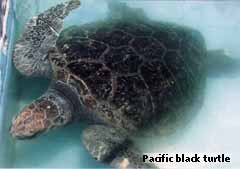
Mexican reserves
 Four of Mexico's 17 beach reserves are located in the
state of Jalisco and managed by the University of Guadalajara in conjunction
with the government and private organizations. Since 1982, the university
has been developing a program to conserve Jalisco's sea turtle population
through protection, research and education. Beach reserves are protected
from poachers to the extent that money will allow. Biologists and students
live and work at camps on remote beaches trying to revive the sea turtle
population. A research program was started in 1987 to study the life patterns
of hatchlings in their first year.
Four of Mexico's 17 beach reserves are located in the
state of Jalisco and managed by the University of Guadalajara in conjunction
with the government and private organizations. Since 1982, the university
has been developing a program to conserve Jalisco's sea turtle population
through protection, research and education. Beach reserves are protected
from poachers to the extent that money will allow. Biologists and students
live and work at camps on remote beaches trying to revive the sea turtle
population. A research program was started in 1987 to study the life patterns
of hatchlings in their first year.
 The government sea turtle station currently supports
a small population of juvenile and adult turtles for research and education.
Holding tanks have been built to hold three species of sea turtle: loggerhead
(Caretta caretta), hawksbill (Eretmochelys imbricata squamata),
and pacific black (Chelo-nia mydas agassizii).
The government sea turtle station currently supports
a small population of juvenile and adult turtles for research and education.
Holding tanks have been built to hold three species of sea turtle: loggerhead
(Caretta caretta), hawksbill (Eretmochelys imbricata squamata),
and pacific black (Chelo-nia mydas agassizii).
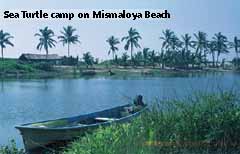
One man steps forward
 In the summer of 1991, Carl Worl planned a three-week
trip to Baja after graduating from Colorado State University. Carl was interested
in experiencing the natural wonders of Baja and wanted to volunteer some
of his time for wild life preservation or a research project.
In the summer of 1991, Carl Worl planned a three-week
trip to Baja after graduating from Colorado State University. Carl was interested
in experiencing the natural wonders of Baja and wanted to volunteer some
of his time for wild life preservation or a research project.
 During his travels, he met Antonio - who needed lots
of help. Antonio's preservation work and research immediately struck a responsive
cord with Carl. Carl started helping with various tasks around the camp:
building palapas, painting, running errands - all those mundane tasks that
are essential to supporting a field station.
During his travels, he met Antonio - who needed lots
of help. Antonio's preservation work and research immediately struck a responsive
cord with Carl. Carl started helping with various tasks around the camp:
building palapas, painting, running errands - all those mundane tasks that
are essential to supporting a field station.
 He was also captivated by Antonio's spirit. "Antonio
has so much enthusiasm. He never stops," explains Carl. "He runs
everywhere - he doesn't walk. He talks so fast and his voice projects so
much ... it lights people up."
He was also captivated by Antonio's spirit. "Antonio
has so much enthusiasm. He never stops," explains Carl. "He runs
everywhere - he doesn't walk. He talks so fast and his voice projects so
much ... it lights people up."
 Carl's three-week trip turned into 5 months.
Carl's three-week trip turned into 5 months.
 In 1992, Carl met Heather Paige, a graphic artist vacationing
in Baja. Heather was discouraged by the people's attitude toward the environment.
"Society is so wasteful, it has to stop at some point," she says.
In 1992, Carl met Heather Paige, a graphic artist vacationing
in Baja. Heather was discouraged by the people's attitude toward the environment.
"Society is so wasteful, it has to stop at some point," she says.
 Working with Antonio and Carl proved to be the anodyne
to her disillusionment. Together, Heather and Carl decided to work together
to further turtle preservation.
Working with Antonio and Carl proved to be the anodyne
to her disillusionment. Together, Heather and Carl decided to work together
to further turtle preservation.
 Later that year they went on a four-month pilgrimage
to Michoacan to do volunteer work, ranging as far south as Guerrero. Visiting
beach after beach, their level of concern escalated.
Later that year they went on a four-month pilgrimage
to Michoacan to do volunteer work, ranging as far south as Guerrero. Visiting
beach after beach, their level of concern escalated.
 "We went to a lot of deserted beaches that didn't
have projects," says Carl. "There were a lot of turtles coming
up and they were all poached. On some beaches, we could count, say, 40 nests
that were all poached - every single one of them."
"We went to a lot of deserted beaches that didn't
have projects," says Carl. "There were a lot of turtles coming
up and they were all poached. On some beaches, we could count, say, 40 nests
that were all poached - every single one of them."
 This direct experience of habitat devastation had a
profound effect on Carl and Heather. "The sea turtles seem to be almost
spiritual creatures - great turtle spirits," explains Heather. To allow
the destruction to continue was unacceptable.
This direct experience of habitat devastation had a
profound effect on Carl and Heather. "The sea turtles seem to be almost
spiritual creatures - great turtle spirits," explains Heather. To allow
the destruction to continue was unacceptable.
 Carl and Heather are unable to say exactly when or how
they decided to commit themselves to sea turtle preservation; however, the
future direction of their lives had been decided.
Carl and Heather are unable to say exactly when or how
they decided to commit themselves to sea turtle preservation; however, the
future direction of their lives had been decided.
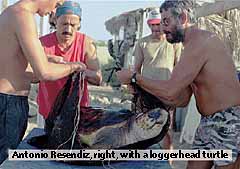
Spreading the word
 Having experienced the personal transformation resulting
from direct exposure to the destruction of species and natural habitats,
they committed themselves to finding a way to share the experience.
Having experienced the personal transformation resulting
from direct exposure to the destruction of species and natural habitats,
they committed themselves to finding a way to share the experience.
 "The biggest problem with environmentalism is pushing
all this literature," says Carl. "I'm not putting it down, because
there's no other alternative. But it doesn't carry the feeling. When Greenpeace
sends the literature about the dolphins, it's so detached .... But if the
people got out and actually went on their boat and saw the animals, then
they might really change their attitudes. I've seen people actually change
when they go and deal with the animals - do the work to help them. But when
they just see it on TV, it's just another thing."
"The biggest problem with environmentalism is pushing
all this literature," says Carl. "I'm not putting it down, because
there's no other alternative. But it doesn't carry the feeling. When Greenpeace
sends the literature about the dolphins, it's so detached .... But if the
people got out and actually went on their boat and saw the animals, then
they might really change their attitudes. I've seen people actually change
when they go and deal with the animals - do the work to help them. But when
they just see it on TV, it's just another thing."
 Contacting a number of well-known environmental groups,
they discovered that most were charging "volunteers" $900 a week
and up! Many individuals were more than willing to donate labor and some
money, but these rates were simply beyond most budgets.
Contacting a number of well-known environmental groups,
they discovered that most were charging "volunteers" $900 a week
and up! Many individuals were more than willing to donate labor and some
money, but these rates were simply beyond most budgets.
 After a little more digging, they discovered that there
were many biologists and small conservation projects that needed their kind
of support. They soon recognized the need for a low-cost alternative - a
way to pair willing (but not rich) volunteers like themselves with scientists
doing critical, but often underfunded, field research. They realized that
the scientists' efforts alone are inadequate - there simply aren't enough
of them. Moreover, achieving their goals will take the whole community working
together.
After a little more digging, they discovered that there
were many biologists and small conservation projects that needed their kind
of support. They soon recognized the need for a low-cost alternative - a
way to pair willing (but not rich) volunteers like themselves with scientists
doing critical, but often underfunded, field research. They realized that
the scientists' efforts alone are inadequate - there simply aren't enough
of them. Moreover, achieving their goals will take the whole community working
together.
 In 1993, Carl and Heather formed One World Work Force
(OWWF), a nonprofit organization, expressly to address this need. The goal
of OWWF is to provide others with the opportunity to lend a hand with conservation
research, species protection and other efforts to save our planet. By maintaining
a low overhead and using donated equipment, they offer the chance to spend
a week working with a scientist in the field at half the cost of other organizations.
Their small staff is supplemented by volunteer assistance.
In 1993, Carl and Heather formed One World Work Force
(OWWF), a nonprofit organization, expressly to address this need. The goal
of OWWF is to provide others with the opportunity to lend a hand with conservation
research, species protection and other efforts to save our planet. By maintaining
a low overhead and using donated equipment, they offer the chance to spend
a week working with a scientist in the field at half the cost of other organizations.
Their small staff is supplemented by volunteer assistance.
 Carl is pleased with the support that OWWF is getting
from scientists and biologists. "The scientific community is taking
us as being credible, instead of just a super eco-tour company," he
states.
Carl is pleased with the support that OWWF is getting
from scientists and biologists. "The scientific community is taking
us as being credible, instead of just a super eco-tour company," he
states.
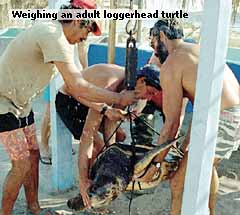
OWWF takes off
 OWWF is offering three trips in 1994 focused on scientific
research, education, habitat restoration and hands-on protection of female
sea turtles and their eggs during the nesting season. The trips will be
to Antonio's center at Bahia de Los Angeles and to Tenacatita Beach and
Mismaloya Beach on the Mexican mainland.
OWWF is offering three trips in 1994 focused on scientific
research, education, habitat restoration and hands-on protection of female
sea turtles and their eggs during the nesting season. The trips will be
to Antonio's center at Bahia de Los Angeles and to Tenacatita Beach and
Mismaloya Beach on the Mexican mainland.
 At Bahia de los Angeles, OWWF makes their base camp
at Campo Archelon. To those for whom "nature" means tall forests
and green valleys, the site may appear desolate. But to those familiar with
the deserts of the Southwest, it is a fragile paradise.
At Bahia de los Angeles, OWWF makes their base camp
at Campo Archelon. To those for whom "nature" means tall forests
and green valleys, the site may appear desolate. But to those familiar with
the deserts of the Southwest, it is a fragile paradise.
 "The area has towering mountains, tons of endemic
wildlife and plants - like 80 species of cactus found only in that area
- pristine beaches and warm, crystal-clear water," says Carl. "The
camp is natural and beautiful. The palapas are right on the beach. There
is excellent snorkeling right off the beach. The camp is natural - not developed
at all. Cactus grows right next to the palapas. Little roads wind through
the elephant trees."
"The area has towering mountains, tons of endemic
wildlife and plants - like 80 species of cactus found only in that area
- pristine beaches and warm, crystal-clear water," says Carl. "The
camp is natural and beautiful. The palapas are right on the beach. There
is excellent snorkeling right off the beach. The camp is natural - not developed
at all. Cactus grows right next to the palapas. Little roads wind through
the elephant trees."
 Each morning, the team helps clean and refill the turtle
tanks. Other daily projects include collecting food for the turtles in order
to maintain their natural diet. This entails snorkeling for seaweed and
spearfishing for fish and stingray. While maintaining the center, the Resendiz
utilize volunteers in numerous other projects, ranging from shark parasites
to sea hares (Aplysia californica).
Each morning, the team helps clean and refill the turtle
tanks. Other daily projects include collecting food for the turtles in order
to maintain their natural diet. This entails snorkeling for seaweed and
spearfishing for fish and stingray. While maintaining the center, the Resendiz
utilize volunteers in numerous other projects, ranging from shark parasites
to sea hares (Aplysia californica).
 While aiding in the research conducted by Antonio and
Bety, volunteers also collect data for Scott Eckert of Hubbs-Sea World.
Efforts to protect sea turtles are handicapped by lack of knowledge of their
life cycles, migration patterns, food preferences, social structure, and
growth rates - all issues that volunteers help these researchers tackle.
Without the volunteer efforts, it would be impossible for any of this on-water
data collection and research to take place.
While aiding in the research conducted by Antonio and
Bety, volunteers also collect data for Scott Eckert of Hubbs-Sea World.
Efforts to protect sea turtles are handicapped by lack of knowledge of their
life cycles, migration patterns, food preferences, social structure, and
growth rates - all issues that volunteers help these researchers tackle.
Without the volunteer efforts, it would be impossible for any of this on-water
data collection and research to take place.
 It has been said that there are no extraordinary individuals
- only ordinary individuals with an extraordinary commitment. Antonio, Bety,
Carl and Heather embody that commitment, and invite you to join them for
an extraordinary experience.
It has been said that there are no extraordinary individuals
- only ordinary individuals with an extraordinary commitment. Antonio, Bety,
Carl and Heather embody that commitment, and invite you to join them for
an extraordinary experience.

The lost arribada
 Twenty years ago the Mexican state of Jalisco received
an arribada, one of nature's most awesome events. The arribada, Spanish
for "arrival", is a peculiar nesting event of the olive ridley.
In a span of only a few days, wave after wave, thousand upon thousand of
females come ashore to lay their eggs. Local fishermen who experienced it
twenty years ago claim that a person could walk down the beach on the backs
of the turtles without ever touching the sand.
Twenty years ago the Mexican state of Jalisco received
an arribada, one of nature's most awesome events. The arribada, Spanish
for "arrival", is a peculiar nesting event of the olive ridley.
In a span of only a few days, wave after wave, thousand upon thousand of
females come ashore to lay their eggs. Local fishermen who experienced it
twenty years ago claim that a person could walk down the beach on the backs
of the turtles without ever touching the sand.
 At the arrival of the arribada, turtles and eggs were
harvested intensively for food and leather. The massive number of turtles
gave the false impression of an unlimited, never-ending, source of turtles.
At the arrival of the arribada, turtles and eggs were
harvested intensively for food and leather. The massive number of turtles
gave the false impression of an unlimited, never-ending, source of turtles.
 The arribada no longer comes to the beaches of Jalisco.
The olive ridley population there has plummeted from approximately 20,000
- 30,000 nesting turtles in the 1960s to only about 1,000 today. Worldwide,
only 4 of the 7 beaches that used to host the arribada still experience
them.
The arribada no longer comes to the beaches of Jalisco.
The olive ridley population there has plummeted from approximately 20,000
- 30,000 nesting turtles in the 1960s to only about 1,000 today. Worldwide,
only 4 of the 7 beaches that used to host the arribada still experience
them.
 Listed as an endangered species, the olive ridley now
nests intermittently in Jalisco over a broad expanse of beach, making conservation
efforts difficult and expensive.
Listed as an endangered species, the olive ridley now
nests intermittently in Jalisco over a broad expanse of beach, making conservation
efforts difficult and expensive.

A turtle nursery story
 One key project is the maintenance of a sea turtle "nursery."
Sea turtle nests are carefully dug up and removed from the beach, where
they would be subject to poaching. The eggs are then reburied in the "nursery,"
a fenced-in compound where their temperature, moisture and development can
be monitored. When the eggs hatch, the young turtles are released into the
ocean.
One key project is the maintenance of a sea turtle "nursery."
Sea turtle nests are carefully dug up and removed from the beach, where
they would be subject to poaching. The eggs are then reburied in the "nursery,"
a fenced-in compound where their temperature, moisture and development can
be monitored. When the eggs hatch, the young turtles are released into the
ocean.
 On one small beach, this might seem to have an insignificant
impact. The numbers tell a different story.
On one small beach, this might seem to have an insignificant
impact. The numbers tell a different story.
 A sea turtle lays between 50 and 200 eggs in each nest,
which is buried in the sand. About 80 percent of these eggs may eventually
hatch and produce baby turtles. A baby turtle is very delicate. A wide variety
of natural and man-made obstacles drastically reduce their numbers.
A sea turtle lays between 50 and 200 eggs in each nest,
which is buried in the sand. About 80 percent of these eggs may eventually
hatch and produce baby turtles. A baby turtle is very delicate. A wide variety
of natural and man-made obstacles drastically reduce their numbers.
 Natural beach erosion can uncover the eggs, destroying
a whole season's nesting. Animals like coyotes and racoons (and man, of
course) dig up and destroy nests.
Natural beach erosion can uncover the eggs, destroying
a whole season's nesting. Animals like coyotes and racoons (and man, of
course) dig up and destroy nests.
 After emerging from the nest, the baby turtles immediately
head for the ocean. Before reaching the water they are subject to additional
problems. Crabs and birds, in addition to racoons and coyotes, find the
young turtles a tasty meal. A tire track in the sand can trap an entire
nest of young. The young are drawn to the light, so any man-made lighting
will interfere with their trek to the sea, as will sunlight if they emerge
during the day. Having to cross a road to reach the beach is obviously a
problem.
After emerging from the nest, the baby turtles immediately
head for the ocean. Before reaching the water they are subject to additional
problems. Crabs and birds, in addition to racoons and coyotes, find the
young turtles a tasty meal. A tire track in the sand can trap an entire
nest of young. The young are drawn to the light, so any man-made lighting
will interfere with their trek to the sea, as will sunlight if they emerge
during the day. Having to cross a road to reach the beach is obviously a
problem.
 Once in the water, the turtles swim out to sea. They
probably swim for two days - the amount of food reserves they are born with
- without stopping. Of course, once in the water they are preyed upon by
sharks and other large fish, such as the skipjack.
Once in the water, the turtles swim out to sea. They
probably swim for two days - the amount of food reserves they are born with
- without stopping. Of course, once in the water they are preyed upon by
sharks and other large fish, such as the skipjack.
 It is estimated that less than one percent of the turtles
survive to maturity.
It is estimated that less than one percent of the turtles
survive to maturity.
 Eliminating land-based predators and ensuring that all
of the young turtles make it to the sea greatly increases their survival
rate. Although natural survival rates are not accurately known, one nest
that makes it to the nursery may produce the equivalent of five or 10 nests
on the beach. Survival from ten nests in the nursery may be the equivalent
of 100 "natural" nests!
Eliminating land-based predators and ensuring that all
of the young turtles make it to the sea greatly increases their survival
rate. Although natural survival rates are not accurately known, one nest
that makes it to the nursery may produce the equivalent of five or 10 nests
on the beach. Survival from ten nests in the nursery may be the equivalent
of 100 "natural" nests!
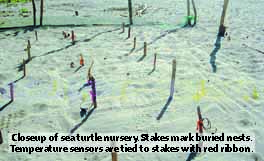

Alice Martinez is a long-term San Diego resident, environmental reporter,
computer specialist, and San Diego Earth Day volunteer.










Twenty years ago the Mexican state of Jalisco received an arribada, one of nature's most awesome events. The arribada, Spanish for "arrival", is a peculiar nesting event of the olive ridley. In a span of only a few days, wave after wave, thousand upon thousand of females come ashore to lay their eggs. Local fishermen who experienced it twenty years ago claim that a person could walk down the beach on the backs of the turtles without ever touching the sand.
At the arrival of the arribada, turtles and eggs were harvested intensively for food and leather. The massive number of turtles gave the false impression of an unlimited, never-ending, source of turtles.
The arribada no longer comes to the beaches of Jalisco. The olive ridley population there has plummeted from approximately 20,000 - 30,000 nesting turtles in the 1960s to only about 1,000 today. Worldwide, only 4 of the 7 beaches that used to host the arribada still experience them.
Listed as an endangered species, the olive ridley now nests intermittently in Jalisco over a broad expanse of beach, making conservation efforts difficult and expensive.
